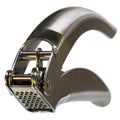Maillard sounds like my-yar.
The French like to use a lot of unpronounced letters. On the other hand, they also use a lot of butter, so they get a pass. The Maillard Reaction is named after Louis-Camille Maillard, a French chemist who was studying the "browning effect" in 1912.
Essentially, the Maillard reaction is responsible for the flavors and aromas created when food is heated enough that the amino acids and sugars start to dance together. The sweet spot is 280-330F with the reaction accelerating the hotter (or more alkaline) it is.
If you leave your food at these temps too long, you get the My Yard reaction, which is when charred food is hurled out the front door onto the yard, accompanied by a smoke detector symphony.
Different foods react in distinct ways during the Maillard Reaction. Hundreds of different flavor compounds are created during the reaction, and they interact with one another and break down to form yet more flavor compounds. The result is complex flavor that would be impossible without prolonged exposure to high heat.
The list of foods improved by the Maillard reaction is endless. Anything that you cook until it gets darker is dependent upon it. Meats and baked goods are obvious, but we can also thank Maillard for Chocolate, coffee, and anything deep fried. Essentially, if it tastes good, think Maillard.
Water inhibits the Maillard reaction, which is why very few foods are improved with boiling. I'm Scandinavian, so I've endured my share of boiled potatoes, boiled vegetables and boiled fish. Boiling is a fantastic cooking method if you enjoy unremarkable flavors, textures and colors. It creates baby food without the neat little jars. A pot of boiling water is a murder weapon, and the victim is flavor.
There's a better option: Join the Dark Side.
Top 5 Tips to Get More Maillard in Your Life
1. Dry is Good. Water inhibits the Maillard reaction. If you struggle to get instagram worthy browning on your food-dry it before you cook it. Use paper towels to dab the moisture off of meats before they go on the heat and you'll get better browning immediately. Pre cook veggies that contain a lot of moisture (mushrooms, onions, etc) before you add them to quiches or pizzas to avoid standing water on your food and soggy crusts.
2. Preheat. Grills, skillets, and ovens all work better when they are hot before you add your food. You'll get less sticking, shorter cook times, and more Maillard when you preheat. I heat my skillet for 4-5 minutes on medium heat before I add food to it. Same with my grill. Ovens all have preheat indicators-use them.
3. Don't crowd. I used to fill my skillet with meat and veggies and wonder why meals turned out bland and mushy. When you overcrowd a skillet, you lower the surface temp and your ingredients sweat moisture faster than the heat can evaporate it. You end up boiling/steaming your food with zero Maillard. The solution is simple: Batching. Never fill your skillet so full that you can't see at least 20% of the cooking surface. For one stir fry, I might cook it in 5-6 batches, transferring perfectly browned and crisped meat and veggies out of my skillet into a serving dish as soon as they are almost done (they continue cooking after being removed from heat), and adding another batch of raw ingredients into my still-hot skillet. It doesn't take any longer, and the results are superior in appearance, texture, and flavor.
4. Don't play with your food. You know who you are. Hovering over food as it tries to cook. Turning burgers 17 times. Stirring ingredients constantly. Opening the oven door to "check" every 2 minutes like the kitchen equivalent of a helicopter parent. Just stop. Moving food before it has time to reach surface temps over 280 F prevents flavor development. Put your hands away and use your nose instead. Not like that-you'll burn your face. The aroma of the Maillard reaction taking place will alert you when your food is ready to turn. If it's steaming, its not ready. If it's sizzling, it's working. If it's smoking, you waited too long. Develop the ability to smell when foods are ready to turn, and you'll be an unstoppable kitchen multitasker.
5. Embrace the Broiler. If you want flavor, it's time to get reacquainted with the broiler in your oven. Yes, it is the oven setting most frequently associated with smoke alarms-but breads, pizzas, pies, steaks, chicken, mac'n cheese, and just about everything else that benefits from a crispy browned top surface can be perfected in less than 3 minutes with your broiler set on High. I recommend leaving the oven door cracked so you can watch your food the entire time. Forget it for a moment, and you'll be doing the non-athletic version of the olympic torch run to the door. But do it right, and you'll be rewarded with beautiful food with maximum flavor.






Comments (3)
I was so happy to read the comment about the “My Yard” reaction. It seems many sites and establishments are producing foods they brag about as CHARRED. To me that’s burned and I hate even a little bit of it.
Thanks Linds-glad it was helpful!
Thank you thank you for this post! It directly addresses both things I am doing wrong (over crowding) and things I’ve not been quite sure of – that dang broiler. Please keep writing!